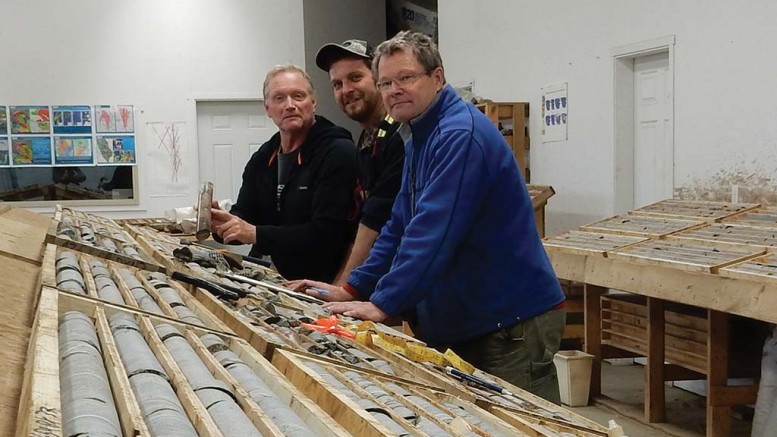VANCOUVER — Recent drill results from EnGold Mines’ Aurizon South gold-copper-silver zone, 14 km from the town of Lac La Hache in central B.C., is casting a renewed light on structurally controlled, high-grade gold systems in a region known for its copper-gold porphyry deposits.
The 3,000-metre program has extended a gold-bearing structure to a 400-metre strike length and 600-metre vertical depth, with intercepts such as 14.3 grams gold per tonne, 2.3 grams silver per tonne and 0.2% copper over 1 metre, and 8 grams gold, 4.7 grams silver and 0.2% copper over 2 metres.
EnGold president and CEO David Brett says the extension of the Aurizon South zone speaks to the “overlooked potential” of the company’s Lac La Hache property, despite it having been picked at by explorers for decades.
“Our property is historically known for its copper potential. It has copper-gold porphyries, a copper-magnetite skarn that we’ve outlined in a resource, and it’s in a region with a lot of open-pit, copper-gold mines, like Mount Polley, New Afton and New Prosperity. It’s always been explored with that bulk-tonnage, porphyry model in mind, but it’s never been recognized for its porphyry-related, high-grade gold systems that could be more amendable to underground mining,” he tells The Northern Miner during a phone interview.
The company changed its name from GWR Resources earlier this year, signalling a shift in focus from copper to gold.
“A lot of what you’d consider ‘small’ underground gold miners have really come into their own in recent years. You can build a company that’s worth half a billion dollars based on a high-grade underground gold mine, because they’re low cost, low capex and you can bring them on-stream faster,” he says. “It used to be the bigger the better, but now the smaller deposits are attracting more attention, and we think Aurizon is how we’re going to build a mid-tier company.”
Across EnGold’s 183 sq. km property, a number of prospects dot along a 10 km long belt of intrusive rocks that pierce through the volcanic and sedimentary cover.
Previous exploration focused on the Spout magnetite-copper skarn deposit, which hosts 7.6 million indicated tonnes of 11.4% magnetite and 0.3% copper, and 15.8 million inferred tonnes of 8.3% magnetite and 0.2% copper, whereas a number of other skarn- and porphyry-style prospects on the property have been found to date.
In 2007, the company drilled a discovery hole at Aurizon South, which intersected 26 metres of 6.3 grams gold, 4.8 grams silver and 0.9% copper from 316 metres deep, within a hematitic breccia cutting into a potassic-altered monzonite.
Follow-up drilling outlined the prospect as two zones — Central and South — both occurring as sub-vertical, hydrothermal breccias offset by younger, post-mineral faulting.

Visible gold in a sample from a quartz vein at EnGold Mines’ Aurizon project in British Columbia. Engold Mines.
Robert Shives, vice-president of exploration, tells The Northern Miner during a phone interview that Aurizon was first explored as a bulk-tonnage copper target.
“In its earliest drilling, perhaps it wasn’t recognized for what it was,” Shives says. “At the time, drill core samples were often lumped as 3-metre intervals, so some of the gold intercepts could be higher than what they are.”
Shives says that South is shaping up to be a “consistently mineralized, planar structure,” whereas brittle faulting of Central has made the zone hard to follow.
The gold is occasionally enveloped within broad, low-grade copper mineralization, as recorded in a 172-metre intercept of 0.3% copper, 0.42 gram gold per tonne and 1.7 grams silver over 500 metres deep.
A number of oblique-trending and narrow quartz veins carrying visible gold have also been intercepted in recent drilling, with grades of 263 grams gold, 90.5 grams silver and 1.7% copper over 0.1 metre.
“Over the past four years we’ve built a robust geological model that’s standing up quite well to our recent results. What we’re seeing now is gold in veins and breccias, and that’s telling us that perhaps there’s a later silicification event that introduced gold,” he says. “As we go deeper we’re finding wider zones and the grades are increasing, so we may be looking at more tonnes with depth.”
Much of EnGold’s blue sky at Aurizon stems from a soil sampling program completed in 2010, which outlined a 2 km long, north-trending gold-in-soil anomaly extending from the Central zone into the South zone and beyond.
“The Central and South zones make up the strongest gold-in-soil anomaly on the property. The anomaly appears to weaken 100 metres from where we’re drilling, but when we were trenching the area we found a large deposit of glacial clay, and that will suppress most geochemical signatures. We know the anomaly continues intermittently for another kilometre, so we’re encouraged that we can extend this gold-bearing structure even farther.”
The company recently closed an oversubscribed, $1.1-million private placement, in which it issued 5.5 million flow-through units at 20¢ per unit. Each unit has a share and a warrant, exercisable within two years at 30¢ per share.
“We have the funds to continue exploration without dilution, and that’ll allow us to go forward into a late winter program and follow up with more surface and drilling work next year,” he says.
EnGold shares have traded in a 52-week range of 3¢ to 19¢, and traded at 14¢ at press time. The company has 168.4 million shares outstanding for a $24-million market capitalization.


Be the first to comment on "EnGold explores for high-grade gold at Lac La Hache"